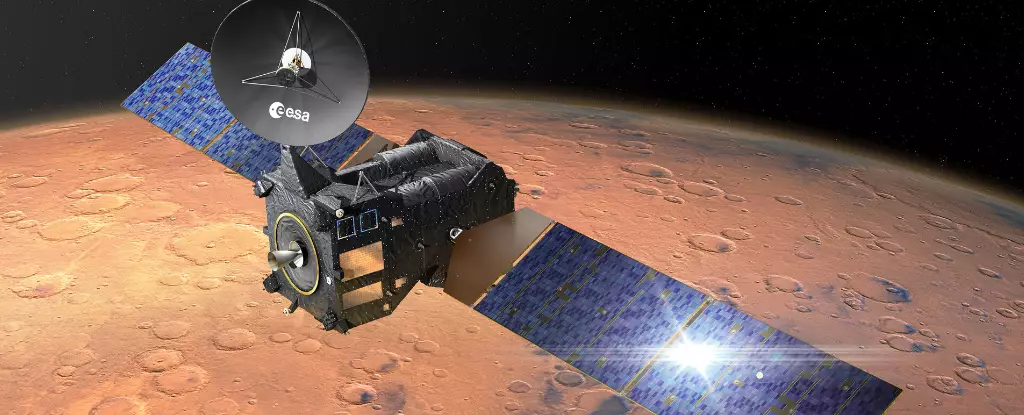In May 2023, an audacious experiment unfolded in the cosmic expanse surrounding Mars, spearheaded by the European Space Agency’s (ESA) Exomars Trace Gas Orbiter (TGO). This endeavor was a part of the multidisciplinary art project titled “A Sign in Space,” aimed at experimenting with citizen scientist engagement in decoding an extraterrestrial-like message. The initiative not only tapped into the realms of science and technology but also sought to mimic the narrative style of Italo Calvino’s “Cosmicomics,” an assemblage of tales that interlace scientific concepts with rich storytelling.
This collaborative project, partnering with established institutions such as the SETI Institute, the Green Bank Observatory, and the Istituto Nazionale di Astrofisica (INAF), set a dramatic stage for a global audience of citizen scientists. With its ambitious goal, the project sought to unravel a mystical communication that, while simulated, ignited fervent imaginations about life’s existence beyond Earth.
When the message was transmitted from Mars, three radio telescopes on Earth were tasked with intercepting and gathering the data from this cosmic signal. This signal wasn’t a straightforward communication; instead, it posed a significant challenge for the citizen scientists involved. Over ten days, an unprecedented coalition emerged, with more than 5,000 individuals from around the globe harnessing their collective intellect and resources in pursuit of decoding this enigmatic transmission.
The complexity of the task attracted not just amateur scientists but also seasoned professionals, cultivating a vibrant community united by curiosity and a quest for discovery. As the days passed, the urgency of the endeavor intensified, punctuated by failed attempts and moments of triumph. Ultimately, after a year of persistence, the breakthrough came from an unexpected duo—Ken and Keli Chaffin, a father-daughter team from the United States. Their success illustrated not only the effectiveness of collaborative science but also the power of diverse perspectives in problem-solving.
Ken Chaffin’s detailed account of the decoding process revealed layers of complexity that reflected the marriage of art and science. By employing a Margolus reversible 2×2 block cellular automata (BCA) approach, the decoded outcome revealed five clusters that represented amino acids—the fundamental building blocks of life. This discovery was encapsulated in a visually striking, retro-inspired image that evoked both wonder and excitement within the scientific community and beyond.
The Chaffin’s method validated the concept that the amalgamation of seemingly basic elements could lead to profound interpretations regarding life itself. The image depicted not just molecules but the potential for life and intelligence, impacting both the scientific discourse and the public imagination.
At the heart of the initiative was Daniela de Paulis, a media artist whose vision infused the project with a unique identity that intertwined the realms of communication arts and astro-physics. As the Artist in Residence at the SETI Institute and the Green Bank Observatory, Daniela leveraged her expertise to guide the project, culminating in a challenge that aimed to transcend conventional scientific boundaries.
Her creation highlighted the role of artistic interpretation in understanding complex scientific concepts. This interplay reached a crescendo when the decoded image was shared, leading to a renaissance of inquiries surrounding the message’s intent. Was it a form of communication, a cultural exchange, or an echo of an imminent threat?
Following the successful decoding, the project’s team took a measured approach to involve the public further. The initiative urged participants not only to share their interpretations but also to delve into the analytical methods employed by the Chaffin family in their decoding efforts. This open call for exploration fostered an environment that encouraged participatory science involving rigorous methodologies while creating a fundamental dialogue on humanity’s readiness for potential contact with extraterrestrial intelligence.
As citizen scientists engage through platforms like Discord, the project evolves into an interactive landscape, where results can be compared, and novel interpretations can be proposed. This dynamic creates a sense of shared ownership of the knowledge generated, symbolizing broader discussions about the responsibilities and ethical considerations of reaching out to intelligent forms of life.
With tasks of decoding complete, the question remains: What does this mean for humanity? The endeavor has transcended scientific limits and entered the realm of philosophical contemplation—on what constitutes communication, connection, and understanding. As the global community continues to scrutinize the decoded message, the ultimate challenge lies in interpreting its meanings and implications.
The experiment stands as a testament to human curiosity and resilience, embodying the innate desire to reach out beyond the stars. As we stand on the precipice of cosmic interaction, the exploration continues—both as scientists and storytellers seeking to forge new paths into the unknown expanses of our universe.


Leave a Reply